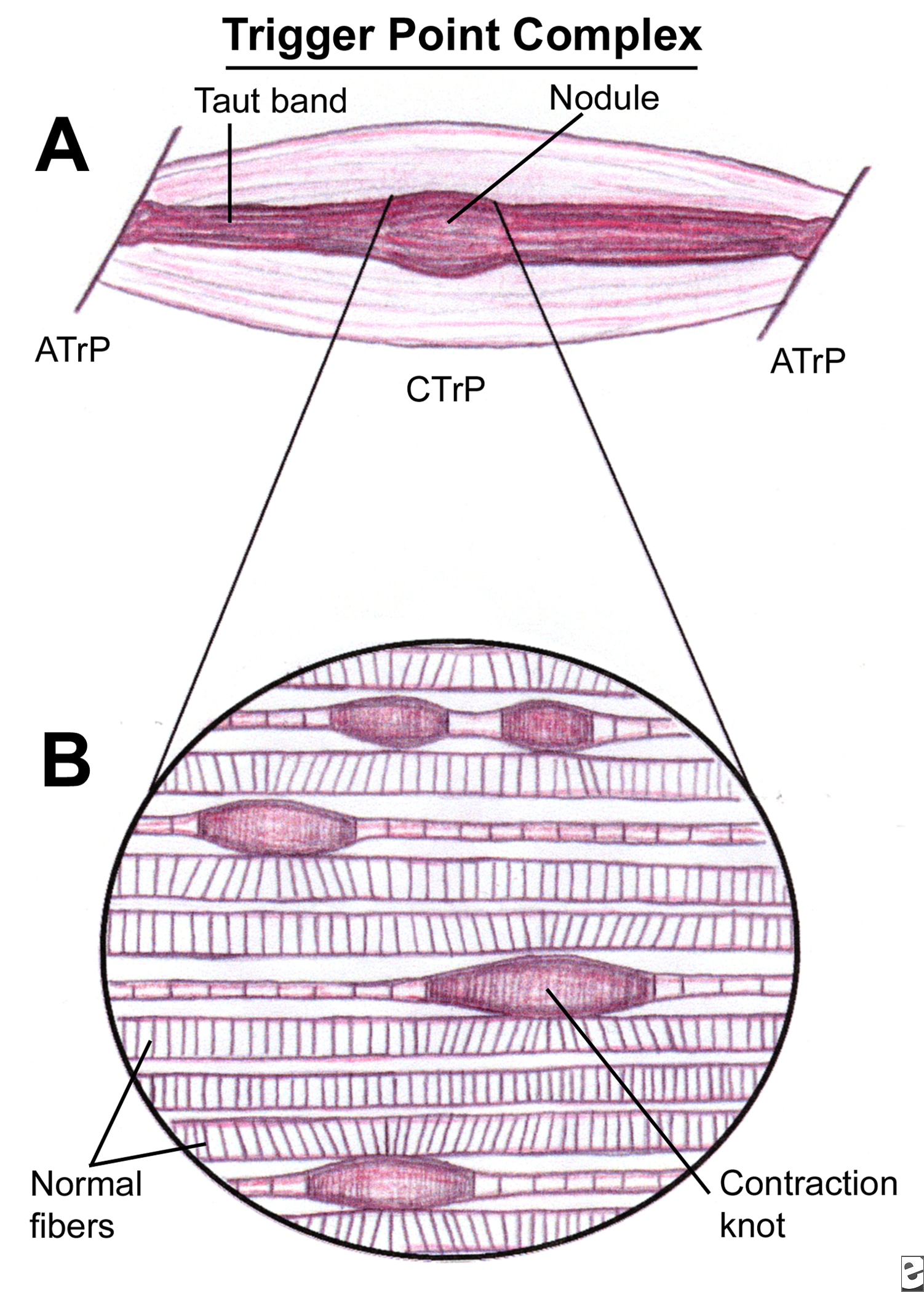Definition 1.
 A focal hyperirritable spot in skeletal muscle associated with a palpable nodule in a taut band: painful on compression and can give rise to characteristic referred pain; tenderness; motor dysfunction and autonomic phenomena (Simons et al., 1999).
A focal hyperirritable spot in skeletal muscle associated with a palpable nodule in a taut band: painful on compression and can give rise to characteristic referred pain; tenderness; motor dysfunction and autonomic phenomena (Simons et al., 1999). Definition 2.
"A trigger point is an area of the soft tissue which, after chronic contraction and reduced blood flow, becomes an area of high neurological activity. For example, fibers in an ischemic muscle (a muscle with low blood) can become an active trigger point in response to biochemical changes in the tissue. Active trigger points cause referred sensation to other parts of the body." www.painreliefvermont.com
Phases of Trigger Points (American Academy of Manual Medicine)
1. Active Trigger Point - Palpable nodular mass within muscles, fascia, scar tissue, ligaments, and periosteum. Produces a subjective referred pain complaint or autonomic phenomena, which is present constantly regardless of activity or rest.
2. (Same as above) produces a subjective referred pain or autonomic phenomena during activity but reduced or eliminated through rest.
3. Latent Trigger Point - (Same as above) but when snapped transversely it may replicate a referral pattern as if it were active. Without direct pressure, it does not produce a subjective referred pain or autonomic phenomena during either activity or rest.
4. Muscle tissue that does not exhibit a palpable ropy or button like nodular mass (characteristic of a TrP). However, the tissue may be hypertonic effecting ROM, structural deviation, and hypersensitive to tactile pressure.
Aetiological factors (what can cause them?)
Travell and Simons (1999)
Direct stimuli = Maggie Simpson Resists Talking
- Mechanical overload
- Sudden cooling of fatigued muscles
- Repetitive usage resulting in fatigue
- Trauma
- Myopathy
- Other TrPs which activate secondary triggers
- Visceral Disease
- Arthropathy
- Neuropathy
- Metabolic dysfunction
- Endocrine dysfunction
- Toxicity
- Infection
- Emotional Distress
How can I treat them?
Good thing about trigger points is that they're predominantly self-treatable and also treatable with massage.
Lacrosse ball! (Check out this clip with Kelly Starrett going through some lower limb demonstrations of how to use the lacrosse ball for self-myofascial release)
Ischaemic compression (While the thumbnail of this vid looks dodgey as hell the explanation of this technique is useful in getting a better idea of how it fits in with what's going on at tissue level. There is no explanation about why he has his shirt off as well?!)
To make up for that last video, here's a chiropractor talking about locating pec minor/major trigger points.
These are just a couple of techniques that can be used. Pettrisage, deep stroking, vibrations are other ways of resolving trigger points but essentially the desired effect is the same, regardless of what technique you use: facilitate localised lymphatic drainage and enhance the flow of oxygenated blood (and therefore nutrients) to the ischaemic area of tissue. Also, as Kstar mentions the video above, we want to improve the ability of the muscle, fascia, nerves etc to slide along the mechanical interfaces of each other to allow for smooth full ROM at each joint.
To finish, Claire Davies uses an analogy that I really find helpful comparing trigger point release to wringing out a wet cloth. A repetetive 'milking' action to rinse out the dirt until fresh water can run through clear (Davies, 2002).

Davies, C (2002) Massage & Bodywork Magazine, Associate Bodywork and Massage Professionals.
Simons, D., Travell, J., Simons, L (1999) Myofascial Pain and Dysfunction: Upper half of body, Lippincott Williams & Wilkins.

